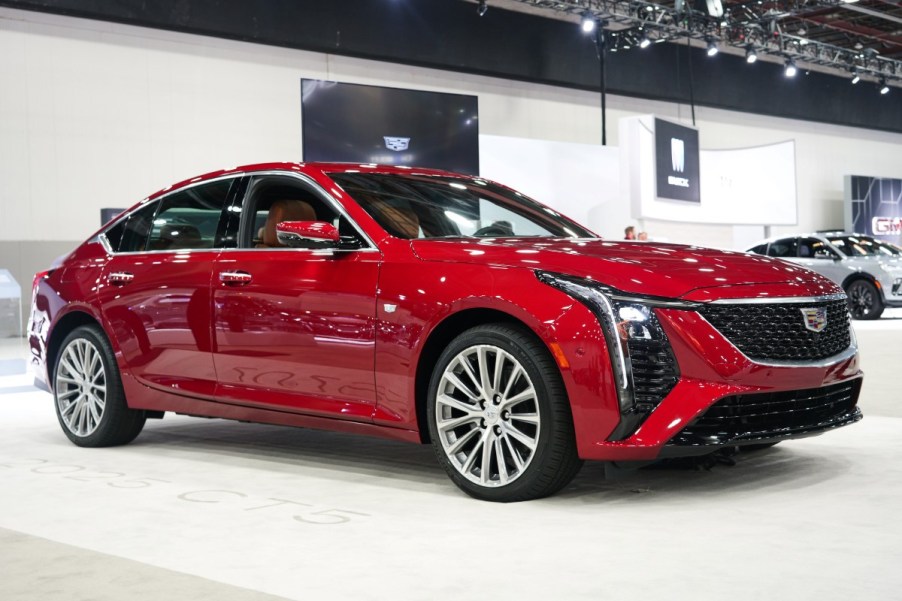
The 2025 Cadillac CT5 Illustrates the Complications of the EV Revolution
Cadillac revealed its 2025 Cadillac CT5 at the Detroit Auto Show, and it is a picture of elegance and class. That’s to be expected, but a deeper look hints at deeper implications. The EV revolution is going to be longer, more complicated, and more challenging than anyone expected.
Cadillac reveals facelifted Cadillac CT5 for 2025

In fairness, the 2025 Cadillac CT5 is quite an attractive vehicle. It’s a fairly minor update, getting some new-school Caddy styling cues from the all-electric Lyriq and Celestiq. The larger front grille really fits the CT5’s large sedan size. And the updated LED lighting is both more distinct and complex than the current car.
Inside, a 33-inch widescreen display houses both the digital instrumentation and infotainment screens. It’s perhaps the most immediately noticeable change, and features an interactive pane to the left of the steering wheel. There’s new tech as well, with a blind-spot intervention system designed to prevent accidents when changing lanes. And the intersection automatic emergency braking is said to prevent collisions with vehicles in cross-traffic.
Under the hood, the 2025 Cadillac CT5 carries over the same engine options as the current car. A 2.0-liter four-cylinder with 237 horsepower and 253 pound-feet of torque, and an optional 3.0-liter twin-turbo V6 with 335 horsepower and 405 pound-feet of torque.
All of these relatively minor changes are to be expected just four years into the CT5’s lifespan. But it is still riding on the Cadillac Alpha platform, just like the CTS that came before it.
Modest refreshes are the norm as gas cars dwindle
Herein lies the problem: automakers aren’t committing to all-new combustion engine platforms as EVs take over. Instead, minor refreshes like those found in the 2025 Cadillac CT5 are to be the norm for ICE vehicles as we move forward. No automaker is going to dump millions into development of an all-new platform when electric cars are (probably?) the next big thing.
GM’s Ultium platform is already underpinning the current Cadillac EV lineup. And as far as its gas-powered cars, what we have now is likely what we’ll have for the foreseeable future.
The EV revolution will take a generation

It’s a tough pill to swallow in the face of unrelenting climate change and environmental disasters. But full adoption of electric vehicles isn’t going to be swift. Like most things in America, lasting change will take considerable time. And whether it’s thanks to cultural, political, or financial factors, gas cars will likely be around for at least another 25 years, if not longer.
The U.S. is not ready for full electric vehicle adoption
Simply put, America is not ready for full EV adoption. The lack of charging infrastructure and the high price of EVs are an undeniable set of facts. MotorTrend contributor Derek Powell recently detailed a story that perfectly illustrates both issues. During a trip with his Rivian R1T, Powell attempted to tow a Porsche Cayman GT4 120 miles from Los Angeles to Buttonwillow for a track day. Out-of-order charging stations, limited opportunities for fast charging, and a range-destroying climb over hilly terrain made the journey tenuous.
And while most daily commutes don’t require that kind of commitment, the charging infrastructure needed to keep thousands of electric vehicles on the road daily just isn’t here today. Barring that, or a reduction of car dependency, full EV adoption isn’t as close as some automakers would like you to believe.
The 2025 Cadillac CT5 still works, for now

Until those issues are solved, cars like the 2025 Cadillac CT5 are just going to keep coming. Even as platforms age into double digits, automakers will continue to extend the lifespan of existing gas-powered vehicles until going electric becomes more tenable. Sure, the 2025 CT5 is the third generation of car on the Alpha platform. But it’ll start to show its age eventually. When that day comes, will CT5 buyers be ready for an EV?




